The National Register of Historic Places lists many properties significant for African American History. We take the opportunity of African American History Month to highlight just some of the properties that exemplify the contributions of African American culture and achievement.
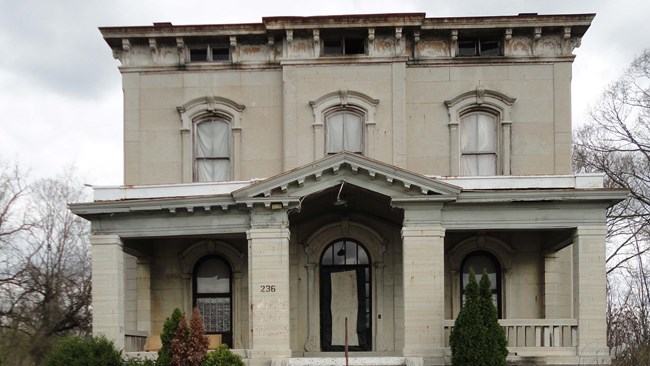
Photograph courtesy of OhioState Historic Preservation Office
Featured Historic Properties for African American History Month:
Summit Street YWCA, Dayton, OhioThe Summit Street YWCA is significant for its association with African American social history through the Young Women's Christian Association (YWCA) and that organization’s mission to promote quality of life and racial equality for Dayton’s African American residents. The building was used as a YWCA from 1942 to 1973. Originally the home was built for Dayton businessman Benjamin Kuhns circa 1874. This was during an era of Dayton’s growth and prosperity late in the nineteenth century.
Regal Theater, Cincinnati, Ohio
The 1914 Regal Theatre building is historically significant for its architecture as one of few extant Beaux Arts-style theaters in Cincinnati, Ohio, and the last remaining theater in the West End neighborhood. The building’s historical significance is tied to African American heritage as well as entertainment and recreation, for its importance in moving pictures and live theater in the West End influencing positive shared experiences through the enjoyment of Black culture films and entertainment acts during most of the 20th century. It is one of few buildings in the vicinity that was not demolished by the public housing projects during the 1930s and 1940s and the Laurel-Richmond Renewal plan and Kenyon-Barr Redevelopment project during the 1950s and 1960s. The building was designed by the architecture firm of Zettle & Rapp.
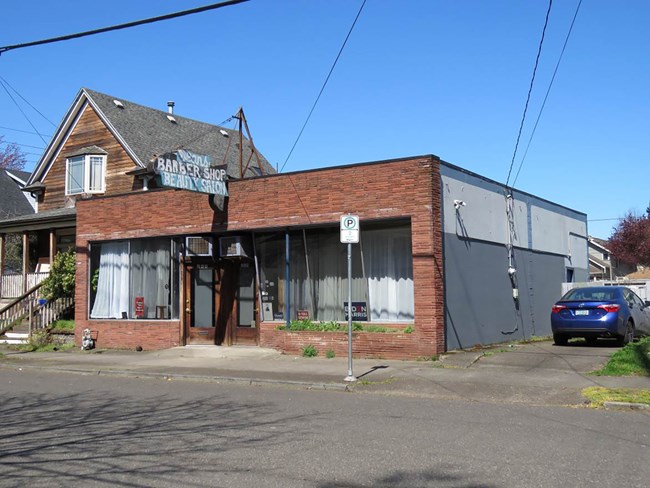
Photograph courtesy of Oregon State Historic Preservation Office
Past Highlights:
Dean's Beauty Salon and Barber Shop, Portland Oregon
Dean’s Beauty Salon and Barber Shop, established by husband and wife Benjamin and Mary Rose Dean in 1956, was among the many barber shops and beauty parlors opened in Lower Albina during the postwar era. It is one of the last extant Black-owned barber shops or salons established in Portland’s Lower Albina neighborhood during the postwar period, and is one of the oldest continuously-operating Black-owned barber shop or salon in Portland.
Hickory Hill Slave and African American Cemetery, Ashland, Virginia
The Hickory Hill Slave and African American Cemetery comprises approximately 4.25 acres of property. The cemetery is west of the antebellum Hickory Hill plantation in Hanover County, Virginia, a short distance east of the town of Ashland. Exceptionally well-documented in historic records, the cemetery provides a window into the changing lives of African American families who have maintained ties to the cemetery from its beginning up to the present day.
Sound 80, Minneapolis, Minnesota
During the 1970s and early 1980s, Sound 80 was widely recognized as the top recording location in the Twin Cities, and amongst the best recording studios in the nation. A young Minneapolis musician, Prince, spent time at Studio 80 in 1977, honing his studio engineering expertise while writing, engineering, producing and playing all the instruments and singing on his demo tapes that landed him a major recording contract in 1977 just after his nineteenth birthday.
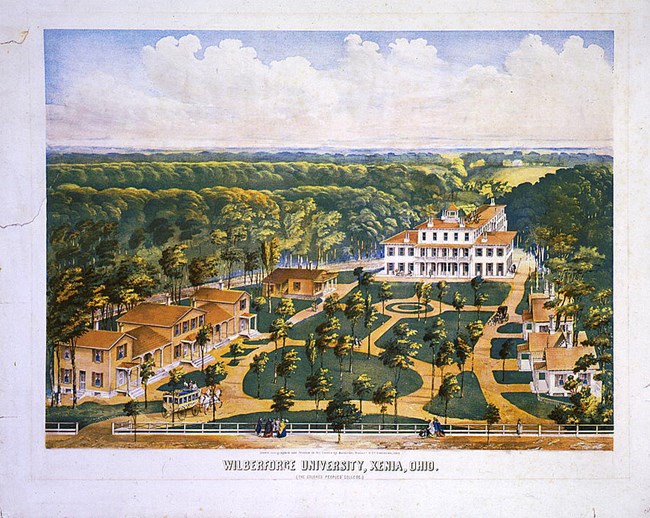
Lithograph courtesy of the Library of Congress
HBCU Grant Recipients in the National Register of Historic Places
Read more . . .
Rosa and Raymond Parks Flat, Detroit, Michigan
The Rosa Parks (McCauley) and Raymond Flat, in Detroit, Michigan, was listed in the National Register of Historic Places in 2021. The building is significant as the home of civil rights icon Rosa Parks, who lived in the first floor flat with her husband Raymond from 1961 to 1988. Parks spent more than half her life in Detroit, not Alabama, and she used the fame she had acquired following the boycott to bring attention to racial inequality in employment, housing, and public accommodations in Detroit and across the country. From the March on Washington in 1963 to boycotts in the 1980s, from the NAACP to the Black Power movement to anti-apartheid, Parks made her presence felt as a leader of the civil rights movement. Throughout those years, she lived at 3201 Virginia Park Street.
Nugent House, Louisville, Kentucky
Sisters Georgia and Alice Nugent purchased the house at 845 South 6th Street on June 10, 1919. Advocating for sex equality and Black women’s access to education, both sisters played a pivotal role in Kentucky’s Black women’s suffrage movement and Black women’s clubs. They lived in the two-and-a-half story house until their deaths in 1940 and 1971, respectively.
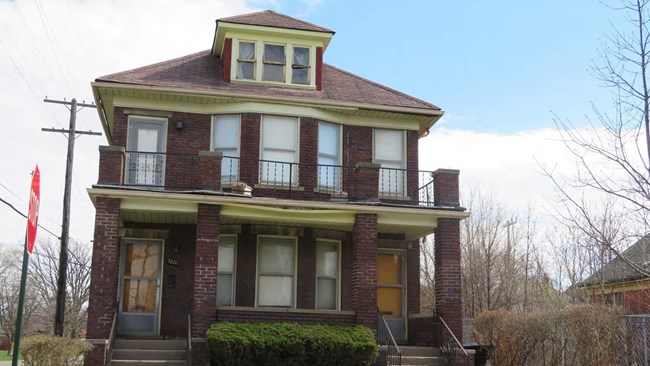
Photograph by Quinn Evans Architects, courtesy of Michigan State Historic Preservation Office
Green Book Properties Listed in the National Register
The Green Book, also known as The Negro Motorist Green Book, and later, The Negro Travelers’ Green Book, was a travel guide for African Americans, published from 1936 to 1966. The annual guide was designed to show businesses that did not discriminate against Black travelers.
Morgan State University Memorial Chapel, Baltimore, Maryland
The Morgan State University Memorial Chapel, on Morgan State University's academic quad and main campus in northeast Baltimore City, Maryland was listed in the National Register of Historic Places in 2018. The chapel is an irregular-shaped one-story masonry building that was constructed in 1941. Designed by the prominent African-American architect Albert Irvin Cassell, FAIA (1985-1969), the building embodies a modem interpretation of the Collegiate Gothic style. Records of the American Institute of Architects indicate that Cassell was the eighth registered African American architect in the nation. In addition to several projects on Morgan's campus, Cassell is noted for having designed buildings for several Historically Black Colleges and Universities (HBCU).
Shaffer's Chapel African Methodist Episcopal Church, Butte, Montana
On the corner of South Idaho and Platinum Avenue sits the historic 116‐year old Shaffer’s Chapel African Methodist Episcopal Church, a cornerstone and conduit for African American life in Butte and beyond for over five decades. The church was a locus for political activism, benevolent work, and educational outreach in the south‐central Butte community of Emma that soon influenced other communities in Anaconda, Helena, Missoula, Bozeman, and Great Falls.
Mount Pleasant Beech Church and Beech Cemetery, Carthage, Indiana
The Beech Cemetery, located in Carthage, Indiana, is typical of rural Indiana cemeteries established in the early-to-mid-nineteenth century, with burials arranged in rows and a wide range of stone grave markers in various styles popular between the 1830s and the 1900s. These resources are the last remaining community landmarks of the Beech Settlement and offer a unique connection to Indiana’s African American heritage.
Du-Good Chemical Laboratory Building, St. Louis, Missouri
The Du-Good Chemical Laboratory Building, located at 1215-23 South Jefferson Avenue, St. Louis (Independent City), Missouri is significant for its association with Dr. Lincoln I. Diuguid, the first African American to graduate with an advanced degree from Cornell University. He founded the Du-Good Chemical Laboratory (later the Du-Good Chemical Laboratories and Manufacturers, the Du-Good Chemical Manufacturers, and the Du-Good Microanalytical Chemical Laboratory), which occupied the building from 1947 through 2011.
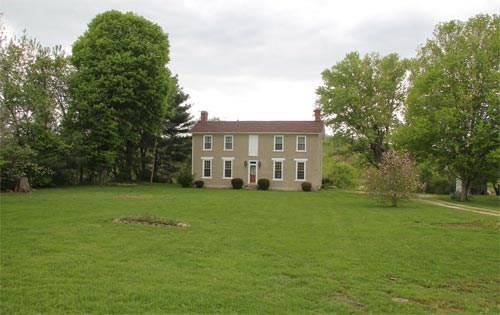
Photograph courtesy of Kentucky State Historic Preservation Office
Lorraine Hansberry Residence, New York, New York
is nationally significant for its association with the pioneering Black lesbian playwright, writer, and activist Lorraine Hansberry. Hansberry resided in a third-floor apartment in the building from 1953 to 1960, the period in which she created her most important works. During her time in the building, she wrote her groundbreaking play, A Raisin in the Sun.
Sandy Island School, Sandy Island, South Carolina
Sandy Island is home to an African American community founded and settled by freed slaves during the Reconstruction era. It is located within the Gullah Geechee Cultural Heritage Corridor, an area established by the U. S. Congress to recognize and help maintain the cultural traditions of the Gullah Geechee people.
Macon County High School, Notasulga, Alabama
Events, students, and faculty at the school during its period of significance are directly associated with Lee v. Macon County Board of Education (1963-2006), the nationally significant landmark Civil Rights case that set a precedent for an enhanced role for the federal government in the desegregation of local schools through judicial relief, direct on-ground intervention, and compliance monitoring.
National Headquarters for the March on Washington for Jobs and Freedom, New York (Harlem), New York
The building is most significant for its association with the theme of African American civil rights during the summer of 1963, when it served as the National Headquarters for the March on Washington for Jobs and Freedom, which took place on August 28, 1963.
Mosquito Beach Historic District, Charleston, South Carolina
The district represents tangible evidence of the widespread segregation of recreational space in the decades leading up to and during the Civil Rights era. Prior to the passing of the Civil Rights Act of 1964, Mosquito Beach became less a convenient gathering place for local workers and more a community beacon during segregation.
Marian Anderson House, Philadelphia, Pennsylvania
The Marian Anderson House is significant for its association with Marian Anderson, a civil rights icon and an African American contralto, who had a ground-breaking career in classical music from the mid-1920s through the late 1950s. During her residence here, her reputation as a performer became solidified and a number of the most important highlights of career took place, including performances at the White House and the concert on the steps of the Lincoln Memorial in Washington, DC (1939). Read more . . .
Grand Lodge of the Colored Knights of Pythias Temple, Dallas Texas
The Grand Lodge of the Colored Knights of Pythias Temple, Texas, (Dallas, Texas) designed by noted African American architect William Sidney Pittman and completed in 1916 served as a center for civic, business, and social life in Dallas at a time when segregation offered few other alternatives. Located in the historic African American Deep Ellum neighborhood at the corner of Elm and Good (now Good-Latimer Expressway) streets, the building housed the state headquarters and grand lodge for the Colored Knights of Pythias, Texas. Read more . . .
Sroufe House, Dover, Kentucky
The documentation, prepared by a Girl Scout, highlights the role the house played in the escape of three enslaved people owned by the Sroufe family. Noted Underground Railroad “conductor” John P. Parker, a free African American man living across the river in Ohio, helped Celia Brooks, her husband, and baby escape bondage and cross the river to freedom. Read more . . .
View Park Historic District, Los Angeles California
The View Park Historic District is associated with the racially restrictive housing practices that left an indelible mark on our country's history, as well as the rise of the black middle- and upper-class in the United States after World War II and their role in combating housing discrimination and segregation. View Park's history parallels the pattern of events that unfolded in Los Angeles and across the country as a result of discriminatory practices in the housing industry and federal policy which restricted housing opportunities from people of color and promoted segregation. After restrictive housing practices were declared unconstitutional, affluent African Americans had a significant role in breaking down housing barriers and promoting improved racial relations. Though early black residents of View Park promoted integration as part of the Civil Rights' era neighborhood stabilization movement, the neighborhood would become predominately black by the end of the 1960s. In doing so, however while retaining its prestige View Park became distinct as one of a small number of neighborhoods in Los Angeles and the country that was both African American and affluent. Read more . . .
Prentiss Normal and Industrial Institute Historic District, Prentiss, Mississippi
Is significant for its role as a leading school for African-American students and for its role in the state's Civil Rights movement.
Norman Film Studios, Jacksonville, Florida
The studio complex, originally developed in 1915 by the Eagle Film Company on the site of a cigar factory, served as the headquarters of the Norman Film Manufacturing Company from 1922 to 1928. At its height, the Norman Film Manufacturing Company was one of the most prominent independent makers of race films in the country, with a national distribution network. "Race films" was a colloquial term to describe movies specifically made for African American audiences.
People's Methodist Episcopal Church, , El Paso, Colorado
The church served its African-American congregation from the time it was built in 1904 until 1965, when the congregation relocated to another building.The neighborhood around the church housed one of the largest African-American communities in the state and the church was constructed in response to the religious and social needs of this community. In the area of Social History, the church further served as the headquarters for the Universal Negro Improvement Association Colorado Springs Division Number 508 from its inception in 1921 to its disbanding in the mid-1930s.
Pierce Street Historic District, Lynchburg, Virginia
The district has a period of significance beginning in 1862 with the creation of Camp Davis, which after the Civil War served as a safe haven for formerly enslaved African Americans under the auspices of the Freedmen's Bureau. The period of significance ends in 1964. Following its use as a military camp and hospital during the Civil War and Reconstruction, the district began developing as a residential neighborhood. By the 1870s, property in the district was being purchased by African Americans who established homes, businesses, and places of worship in a small, two-block cloister surrounded by predominately white neighbors. Over time, an environment developed that fostered the creation or support of notable African American figures in education, literature, aviation, sports, and medicine over multiple generations.
Robert Russa Moton Boyhood Home, Rice, Virginia
The Robert Russa Moton Boyhood Home is eligible for the National Register of Historic Places under Criterion B at the local level of significance for its direct historical association with the formative early life ofRobert Russa Moton (1867-1940), one ofthe most prominent African American educators in the United States in the first decades of the 20th century.
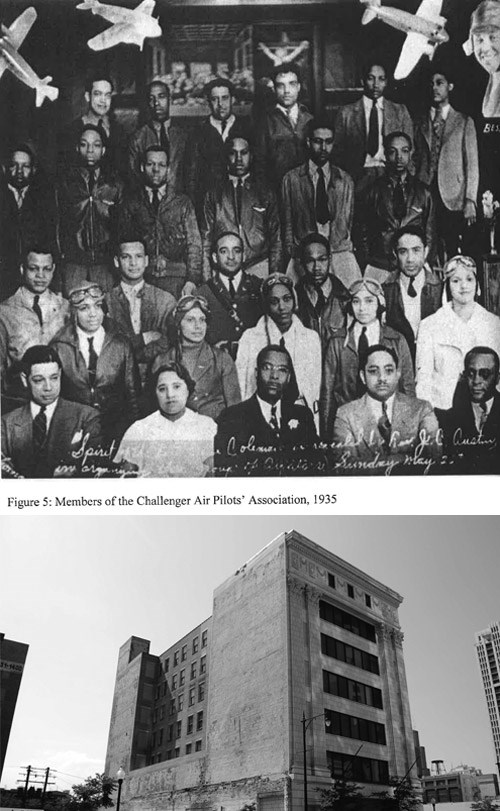
Photograph courtesy of Illinois State Historic Preservation Office
The Linden Center represents a response to the challenges faced by African American citizens in a segregated community early in the 20th century. The Center, conceived, created and administered by African American community leaders, provided comprehensive services that included recreation, medical treatment, educational programming and life skills without regard to race or sex.
Lee, Arthur and Edith, House, Minneapolis, Minnesota
A series of menacing protests described as "riots" in the newspapers enveloped 4600 Columbus Avenue South following its purchase in June 1931 by Arthur and Edith Lee. The young couple was African-American, and they chose to buy a house in the "Field" neighborhood, part of South Minneapolis that area homeowners considered to be a "white neighborhood."
Curtiss-Wright Aeronautical University Building, Chicago, Illinois
During the early 1900s, Chicago emerged as a center for black aviation rivaled only by Los Angeles. The Curtiss-Wright Aeronautical University served as an important entry point for many of the country's pioneering black pilots, who went on to play important roles in the promotion and expansion of black aviation in the United States and abroad.
American Baptist Theological Seminary Historic District, Nashville, Tennessee
American Baptist Theological Seminary (ABTS) committed itself to Christian education and racial equality and fostered leadership among its students who went on to become prominent individuals in local and national civil rights efforts.The success of the Civil Rights Movement in Nashville hinged on student involvement, and indeed, students would become the driving force in the movement as it pushed into the Deep South. John Lewis, Bernard Lafayette, C.T. Vivian and James Bevel were all students at ABTS who came to the movement under the guidance of Reverend Kelly Miller Smith.
Durkee, Joseph H., Athletic Field, Jacksonville, Florida
The present brick stadium, which was renamed Durkee Field shortly after its construction in 1935, is significant for its connections to the African American community, serving as the home of the American Negro League Jacksonville Red Caps and the historically black Edward Waters College football team.
Mound Bayou Historic District, City of Mound Bayou, Mississippi
was founded by freed slaves after the Civil War with no assistance from other communities, what was accomplished is very significant and was accomplished under extremely difficult conditions. The founders and those that carne after them started with a wilderness and created over many years, a thriving self-sufficient community.
Paine College Historic District, Augusta, Richmond County, Georgia
“This is a major milestone in the college’s 131 years of existence, and we look forward to making additional milestones and accomplishments in the legacy of Paine College.” Paine College Historic District, in Augusta, Georgia, was listed in the National Register of Historic Places on December 26, 2012. Representing one of the few institutions of higher education created by a biracial board of trustees in Georgia for African-American students, Paine College Historic District was found historically important on the state level. Important for its role in education and African American heritage.
Vienna High and Industrial School, Dooly County, Georgia
The Vienna High and Industrial School in Vienna, Georgia, was listed in the National Register of Historic Places on December 19, 2012, as an excellent example of an equalization ( an educational facility created to be equal among African-American and white students) school in Georgia and is significant in the areas of architecture, education, ethnic heritage and social history. The International Style school was built in 1959 to accommodate the increasingly overcrowded Vienna County Training School, which was adjacent to the high school.
Montgomery Greyhound Bus Station, Alabama
On May 20, 1961, the Freedom Riders were attacked by a local mob at the Montgomery Greyhound Bus Station in Montgomery, Alabama. The historic importance of the Montgomery Greyhound Bus Station is limited to this one day, but the repercussions from the events brought the Civil Rights struggle into sharp relief and caught national and international attention. Arriving early in Montgomery with only a lone motorcycle patrolman escort, the Freedom Riders soon discovered that a crowd of approximately 200 angry protestors crowded the streets and the arrival bay area at the bus station. Among the crowd were several notorious Klansmen. 20 people were seriously injured, including John Seigenthaler, who was a personal representative of President Kennedy. John Lewis, a student activist who later would become a key figure in the civil rights movement and a U.S. Congressman, was one of the Freedom Riders on this portion of the journey.
Attucks School, Vinita, Craig County, Oklahoma
Constructed in 1916-17, the Attucks School served the black community of Vinita, Oklahoma as a combined elementary, junior, and high school. Stylistically, the school is a combination of a simplified Art Deco and WPA construction. It was not the only black school in Craig County, as there were seven, but it was the only secondary school that was available to blacks until after desegregation in the mid-1950s. While the Vinita public school system readily desegregated as required by law following the landmark decision of Brown vs. Board of Education, it took upwards of three years for desegregation to occur in Vinita.
Mount Zion Baptist Church, Tulsa, Oklahoma
Rebuilding a church and a spirit! Rebuilt after the Tulsa Race Riot of 1921, perhaps the most significant race riot in the history of the United States, the Mount Zion Baptist Church, in Tulsa, Oklahoma, stands as a historic symbol of the local African American community. The commitment of the Mount Zion Baptist Church parishioners in Greenwood to rebuild their church displayed both their tenacity in the face of adversity and their hopes for the future. The Tulsa Race Riot of 1921 resulted in the near complete destruction of the Greenwood African American neighborhood and business district. With no police or fire department protection, whites had burned nearly 30-40 blocks of homes and businesses, and nearly 9000 individuals were left homeless. The Mount Zion Baptist Church remained a landmark and rallying point of the Greenwood neighborhood’s and church’s persistence to survive after the riot.
Berkley Square, Las Vegas, Nevada
The Berkley Square subdivision, which is located in the area historically known as Las Vegas’ Westside, consists of 148 Contemporary Ranch-style homes designed by internationally-known African American architect Paul R. Williams. It was built between 1954 and 1955 and was the first minority (African American) built subdivision in Nevada. Prior to the 1930s, racism was not a problem in Las Vegas simply because there were so few African American residents, but as the African American presence grew, segregation set in. Housing conditions on the Westside, where the African American population was located, were horrible, but planning between the City of Las Vegas and the Federal Housing Authority (FHA) began in 1947 to build a community of affordable modern housing, which resulted in the creation of Berkley Square.
Newburgh Colored Burial Ground, Orange County, New York
It is known that village of Newburgh sustained a modest free black community in the mid-19th century and that the cemetery was actively used c. 1832 to c. 1867, a time when this area remained somewhat isolated from development. Further archeological study of the cemetery will help reveal more of the history of the free black community in that area.
Delmo Community Center, Pemiscot County, Missouri
The community center was the historic social and political center of Homestown, originally known as South Wardell, one of ten communities constructed by the Farm Security Administration for displaced sharecroppers and tenant farmers following the
January 1939 roadside sharecropper demonstration in Southeast Missouri. Though deteriorated, Homestown's Delmo Community Center continues to be an important feature of Southeast Missouri's Delmo communities, and represents an era of community building and social experimentation sponsored by the Federal government.
Birthright, Charles and Bettie, House: Dunklin County, Missouri
Dunklin County's greatness! For more than 40 years this house was home to the Birthrights, former slaves who achieved economic independence and prosperity while building close ties with the families that had held them in slavery and the predominantly white citizenry of Clarkerton and Dunklin Counties. This barber and seamstress amassed substantial wealth from highly successful commercial and farming operations.
John Coltrane House, Philadelphia, Pennsylvania:
Tenor saxophonist and American jazz pioneer John Coltrane lived here from 1952 until two years before his death in 1967. A musician and composer, Coltrane played a central role in the development of jazz during the 1950s and 1960s.
George Black House and Brickyard: Forsyth County, North Carolina
was the house of well-known African American brickmaker George H. Black. Black, sometimes referred to as "The Last Brickmaker in America," lived and worked on this property from 1934 until his death in 1980 at age 101.
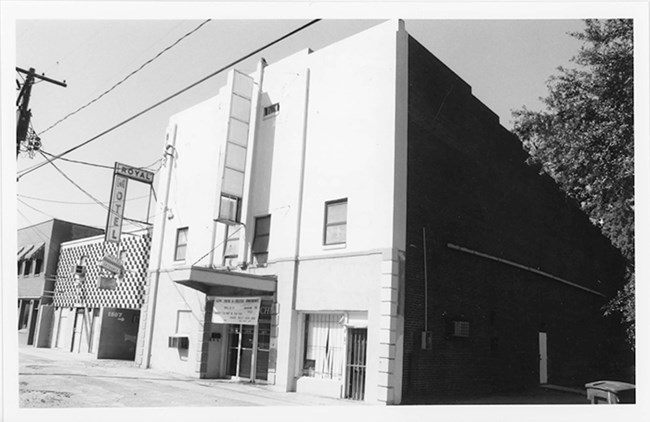
Photograph courtesy of South Carolina State Historic Preservation Office
A post-Civil War African American burial ground
Sweet Home Vocational and Agricultural High School: Guadalupe County, Texas
A Rosenwald school built specifically for the education of African Americans
Gerrit Smith Estate, Madison County, New York
Underground Railroad Site.
Properties associated with Harriet Tubman Underground Railroad Site.
Daisy Bates House, Pulaski County, Arkansas:
Bizzell Library at the University of Oklahoma, Cleveland County, Oklahoma:
Camp Nelson, Jessamine County, Kentucky:
Kentucky's largest recruitment and training center for black troops during the Civil War was also a refugee camp for their wives and children.
Fox Lake, Steuben County, Indiana:
A resort community for African Americans developed during the 1930s in Indiana.
American Beach Historic District, Nassau County, Florida:
American Beach was developed as an ocean front resort for African Americans on the south end of Amelia Island, Florida, in 1935.
Hurricane of 1928 African American Mass Grave, Palm Beach County, Florida
The Hurricane of 1928 African American Mass Burial site is important as the burial site of approximately 674 victims, primarily African American agricultural workers, who were killed in the hurricane of 1928 that devastated South Florida.
Eagle Saloon, Karnofsky Tailor Shop and House, and Iroquois Theater, New Orleans, Louisiana
one of New Orleans' most important neighborhoods in the early development of Jazz.
WROX Building, Coahoma County, Mississippi
For 52 years Wright hosted a weekly R&B show from the WROX building, interviewing musical personalities such as B. B. King, Charlie Pride, Muddy Waters, Tina Turner, Bobby Rush, Sonny Boy Williamson, Robert Nighthawk, Rufus Thomas, Elvis Presley, Little Milton and Pinetop Perkins.
Barton Heights Cemeteries, Richmond, Virginia
These cemeteries were established between c.1815 and c.1865 by black churches, fraternal orders and benevolent organizations and represent early efforts by African Americans to establish their own cemeteries through burial societies that offered death benefits.
Lorraine Apartments, Philadelphia, Pennsylvania
As the largest property owner among African Americans in Philadelphia, the Peace Mission employed many black Philadelphians in restaurants, hotels and small business, while also providing meals, clothing, barbers' services, transportation and lodging at reduced prices.
Pearl High School, Davidson County, Tennessee
The new school was designed by McKissack and McKissack, the nation's first architecture firm owned by an African American.
Lincoln Theater: in the Historic Resources Associated with African Americans in Los Angeles MPS.
Constructed in 1926 the Lincoln Theater is significant as the last remaining theater in Los Angeles that catered to the African American community. The Lincoln Theater opened in 1927 and immediately became a major gathering spot for the large and growing African American population along the Central Avenue Corridor.
Carver Theatre, Richmond County, South Carolina
The Carver Theatre, at 1519 Harden Street in Columbia, South Carolina, is important in the the early-to-mid twentieth century history of Columbia's black community during the later period of racial segregation in the South.
Union Bethel AME Church, Cascade County, Montana
The Union Bethel African Methodist Episcopal Church (AME) in Great Falls, Montana, is one of the first-built and longest-used churches for African Americans in Montana and is important because it represents trends in black community growth in the western United States.
Hinchliffe Stadium, Passaic County, New Jersey
Hinchliffe is possibly the sole surviving regular home field for a Negro League baseball team in the Mid-Atlantic region.
Xavier University Main Building, Convent and Library, New Orleans, Louisiana
Xavier University provided a quality education to thousands of African Americans, principally from New Orleans and elsewhere in Louisiana, who upon graduation entered the New Orleans professional community.
Ivey Delph Apartments, New York, New York
was the first large-scale project by and for African Americans in New York backed by a Federal Housing Administration (FHA) mortgage commitment.
African American Historic Resources of Alexandria, Virginia, Multiple Property Submission: The historic places associated with Alexandria's community of African Americans nominated as components of this multiple property submission (MPS) reflect educational, residential and communal historical development in the city from pre-Civil War antebellum days to post-Civil War freedom.
Bethel Baptist Church, Parsonage, and Guard House, Jefferson County, Alabama
On Christmas Day, 1956, a large bundle of dynamite exploded next to Bethel Baptist Church in Birmingham, Alabama, destroying the parsonage in which Reverend Fred L. Shuttlesworth and his family lived.
Foster Auditorium, Tuscaloosa County, Alabama
The University of Alabama's Foster Auditorium in Tuscaloosa was the site of Governor George Wallace's infamous “stand in the schoolhouse door” in 1963.
Howard High School, New Castle County, Delaware
Howard High School, in Wilmington, Delaware, is one of the schools directly associated with the landmark U.S. Supreme Court decision in Brown v. Board of Education that found racial segregation in public schools to be unconstitutional.
African American Historic Resources of Prince George's County, Maryland MPS: A wealth of historic places in Prince George's County, Maryland, convey how integral African Americas are to the history of this area.
Dorsey--Jones House, Hampshire County, Massachusetts
Located in Northampton, Massachusetts, the Dorsey--Jones House was the home of two escaped slaves, Basil Dorsey (1810-1872) and Thomas H. Jones (1806-1890).
Hotel Theresa, New York, New York: The Hotel Theresa, built from 1912 to 1913, has been one of the major social centers of Harlem.
The Campground, Mobile County, Alabama
The Campground historic district has played an important role in the historical development of the predominately black community of Mobile, Alabama, since the third quarter of the 19th century.
Dorchester Academy Boys' Dormitory, Liberty County, Georgia
Dorchester Academy was founded by the American Missionary Association (AMA) following the Civil War as a primary school for black children.
Abyssinian Meeting House, Cumberland County, Maine
The Abyssinian Meeting House is a vernacular wood-frame building constructed between 1828 and 1831 to serve Portland, Maine’s African American community.
Fort Lyon, Bent County, Colorado
Several companies of African American soldiers were quartered here in anticipation of General Philip Sheridan’s winter campaign against the southern Cheyenne in 1868.
Nash, Rev. J. Edward, Sr., House, Erie County, New York
The Reverend J. Edward Nash, Sr. House is historically significant for its association with the life and career of Buffalo’s most prominent African American leader during the first half of the 20th century.
Paul Laurence Dunbar House, Montgomery County, Ohio
Paul Laurence Dunbar (July 27, 1872-Feburary 9, 1906) holds the distinction of being the first African American poet to receive national acclaim since Phyllis Wheatly.
Langston Hughes House, New York, New York
The Langston Hughes House is historically significant as the home of James Langston Hughes (1902-1967), author and poet and one of the foremost figures in the Harlem Renaissance.
Arna Wendell Bontemps House, Rapides County, Louisiana
the birthplace of writer Arna Bontemps, a major figure in the African American literary movement known as the Harlem Renaissance.
Sherwood Equal Rights Historic District, Cayuga County, New York: Several of the properties within the district were owned by freed slaves; others by prominent abolitionists and women's rights advocates who sprang from the Quaker faith.
Liberty Hill School, Richmond County, North Carolina: this former one-story school, built in 1930, stands at a lonely hilltop location established as a school site in the 19th century for local African American children.
Last updated: February 13, 2025
